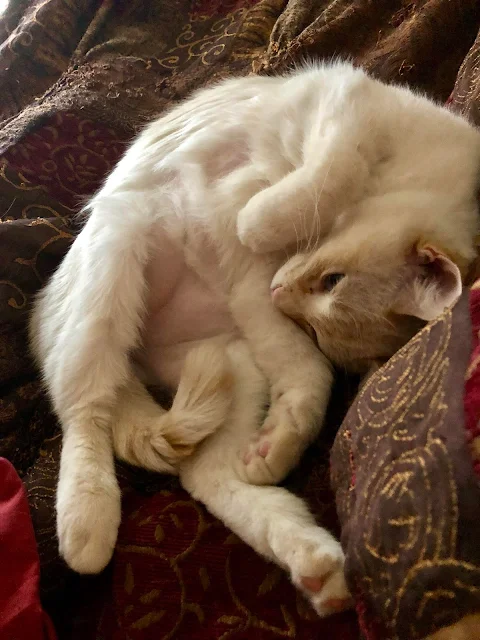This is an aspect of looking after an indoor/outdoor cat which genuinely concerns me. Indoor/outdoor cats go to the toilet outside. Normally you never see it happen. I don't see my cat going to the toilet. I sort of know when he is gone to the toilet because he does it at a similar time each day and I can smell actually that he has just been but I don't know where and I don't see his poop.
And to be perfectly honest I am failing my cat in this respect because at a very simple level it is useful for a cat caregiver to check their cat's poop from time to time. It is a good diagnostic tool. And of course, if your cat is an indoor cat, you will be looking at your cat's poop every day when you clean out the litter tray. It's an automatic, quick check on your cat's digestive system and general health.
A lot of illnesses result in diarrhoea. Diarrhoea, as you no doubt know, is not a disease but a symptom. A common cause is overfeeding because the colon cannot deal with the quantity of food provided.
Food in the small intestine takes about eight hours to get to the colon. The bulk of the food is absorbed at this stage. 80% of water is absorbed in the small bowel. The colon concentrates and stores the waste and at the end of the process a well-formed stool is evacuated containing no mucous, blood or undigested food.
But if the food passes through the intestinal tract rapidly it is incompletely digested and arrives at the rectum in a liquid state. This is diarrhoea. And the transit time down the gastrointestinal tract can be speeded up because the cat has eaten some irritating substances including (this is not a complete list):
- Dead birds, rodents and other dead animals;
- decaying food and garbage;
- foods that are too rich, salts, spices and fat;
- indigestible items such as plastic, paper, cloth et cetera;
- intestine or parasites (endoparasites).
Although it can happen, it is uncommon for a cat to have diarrhoea from eating toxic substances. This is because cats are quite careful about what they eat and they tend to eat slowly. But sometimes toxic substances can be ingested when their cat grooms themselves and clean their feet. These toxic substances can be toxic to the stomach and cause vomiting and diarrhoea. The substances include, for example:
- Tar derivatives, oil, kerosene gasoline;
- refrigerants and cleaning fluids;
- toilet bowl cleaner inserts, bleaches, insecticide;
- mushrooms, ornamental plants and wild plants;
- and building materials such as paints, lime and cement.
Some adult cats and kittens are unable to digest milk and milk byproducts. This is because they are lactose intolerant. Most domestic cats are lactose intolerant because they lack adequate amounts of the enzyme lactase. It causes diarrhea and for kittens it can be very serious because it dehydrates and ultimately it can kill kittens if the problem is left unaddressed.
Finally, some cats experience emotional diarrhoea when they are excited or stressed. If you want to narrow the search for the cause of the diarrhoea you begin by examining the colour, frequency of stools and the odour and consistency.
It is notable that veterinarians suggest that you bring to a veterinary clinic appointment a sample of your cat's stool as it will be useful to your veterinarian in diagnosing illness
Analysing diarrhoea, although it sounds horrible, is a very good way to diagnose the where it has happened in the intestines such as rapid transit or a bacterial infection or malabsorption and then from that you may be able to get a handle on the underlying cause.
- For example, if there are several small stools in an hour with straining the likely location is the colon and the likely cause is colitis according to my veterinary handbook.
- If, in another example, the diarrhoea is putrid, the likely location where this happens is the small bowel and the likely cause is an intestinal infection with bleeding.
- In a third example, if the colour and appearance of the stool is soft and bulky, the location where this occurs is a small bowel (rapid transit) and the likely cause is due to overfeeding or poor-quality diet, high in fibre.
My suggestion if you want to take me up on this would be to occasionally place a litter tray in the home or outside the home with fresh litter substrate in the tray to encourage your cat to use it at which time you will be able to check on their poop.
Of course, you can make an outdoor toilet with sand or some other suitable substance but there's no guarantee that your cat will use it and they might have a variety of locations where they go to the toilet of which you are unaware.
It is very convenient for the caregiver if their cat goes to the toilet outside. Perhaps it is too convenient because you tend to accept it and forget about the advantages of cleaning the litter tray. That's sounds extraordinary but there are advantages in terms of monitoring your cat's health.






